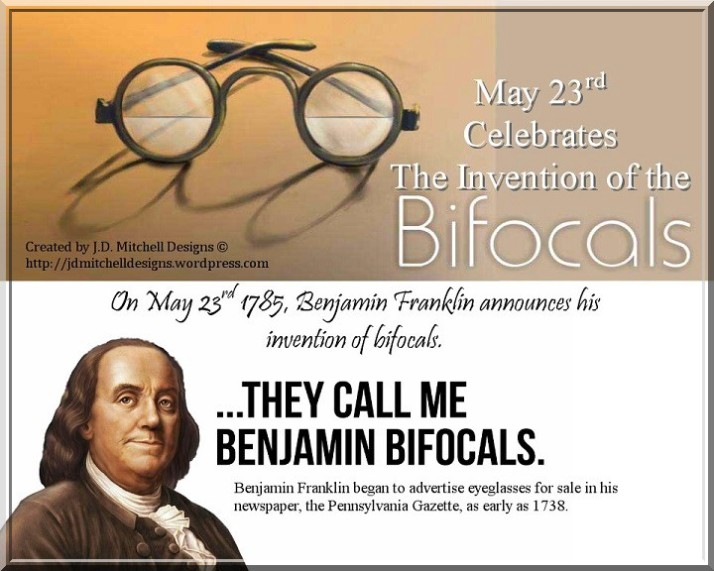
Today on, “Days to Remember,” we celebrate how on May 23rd 1785, Benjamin Franklin announces his invention of bifocals.
I wear bifocals but I didn’t know it was invented in 1785, did you?
So what inspired Benjamin Franklin to inspire the bifocal?
Benjamin Franklin was a hyperope who likely required eyeglasses originally in the 1730s.
By the late 1750s he was usually described wearing them and they became an integral part of his face, at least for distance use.
Many paintings and contemporary sketches and satirical cartoons show him represented wearing his eyeglasses.
He admitted that he could not “distinguish a letter or even of large print without them”.
Benjamin Franklin began to advertise eyeglasses for sale in his newspaper, the Pennsylvania Gazette, as early as 1738.
With moderate hyperopia he would have found eyeglasses to correct farsightedness useful by this time, about age 30.
What is hyperopia? It term used to describe farsighted people.
Von Rohr and several others credit optician Samuel Pierce with making bifocals for Franklin.
Pierce described people wearing bifocals in 1775 and he himself may have worn them in the 1760’s.
Although this is all noted in the Levene’s chapter no hard evidence is presented.
How do they make bifocals now?
Today’s YouTube video shows you how computer technology now grinds your lens to appropriate prescription.
There’s a small commerical in the beginning sorry about that but it’s very informative videos brought to you by user name, (Empire Optical Channel) as we celebrate how on May 23rd 1785, Benjamin Franklin announces his invention of bifocals.
Here are some fun facts, below that you may or may not know about the bio focal lens.
A bifocal lens without a clear dividing line is called a progressive lens. No one can tell you’re wearing progressive lenses.
The lenses are made so that the transition from near vision to far vision is gradual. One potentially limiting factor in progressives is that more lens space is needed for the transition.
The frame you pick needs to have a lens large enough to accommodate the necessary space.
Progressive lenses also can be harder to adjust to than standard bifocals; about 1 in 10 people find them difficult to wear.
Did you know bifocals’ also come in contacts?
Bifocal contacts are not for everyone, however. Bifocal contacts seem to work better as hard contacts rather than soft contacts.
Also, some people find that bifocal contacts don’t provide enough up-close vision to see as sharply as they would like.
Bifocal contacts also can be tricky to fit on your eye. It may take several visits with your eye care provider to get the right fit for you.
The first vision correction device was invented in 1000AD, and called a reading stone.
As you can imagine, it was for farsighted folk who couldn’t read properly, and was basically a glass sphere used as a magnifying glass.
Makes you really thankful for the thin and manageable lenses we have now, doesn’t it?
The first sunglasses, however, date back to 12th century China, where flat crystals of smoky quartz were mounted for personal use to reduce the glare from the sun.
It is also said that these ‘sunglasses’ were used by judges while presiding cases, so as not to give away their emotions. This is the earliest record of sunglasses using ‘lenses’, and materials to see through clearly during daylight or otherwise dates back even further.
You might remember Benjamin Franklin as one of two things, either as a founding father of the United States of America, or the guy who performed the lightning rod experiment.
What many people don’t know, however, is that Benjamin Franklin was also the inventor of bifocals. He was both myopic and hypermetropic, so he developed these special lenses to help him see better. Talk about multi-talented!
As we celebrate today how on May 23rd 1785, Benjamin Franklin announces his invention of bifocals.
Written & Designed by JD Mitchell
jdmitchelldesigns@gmail.com